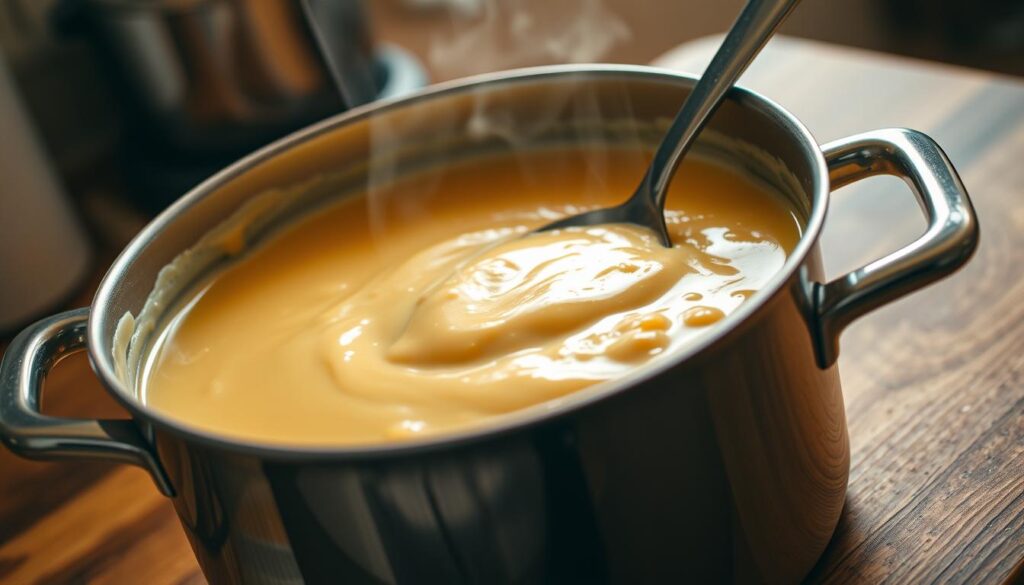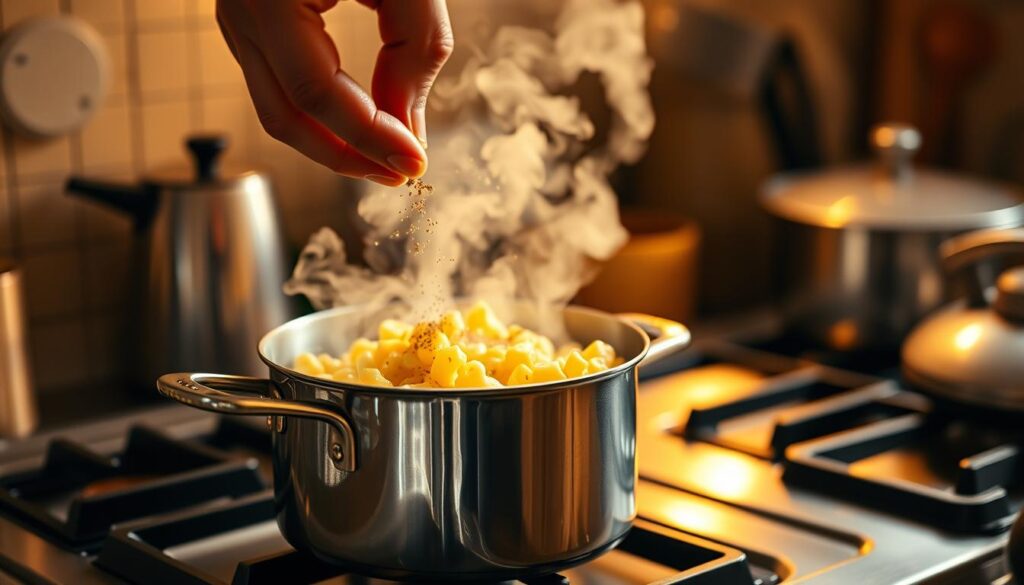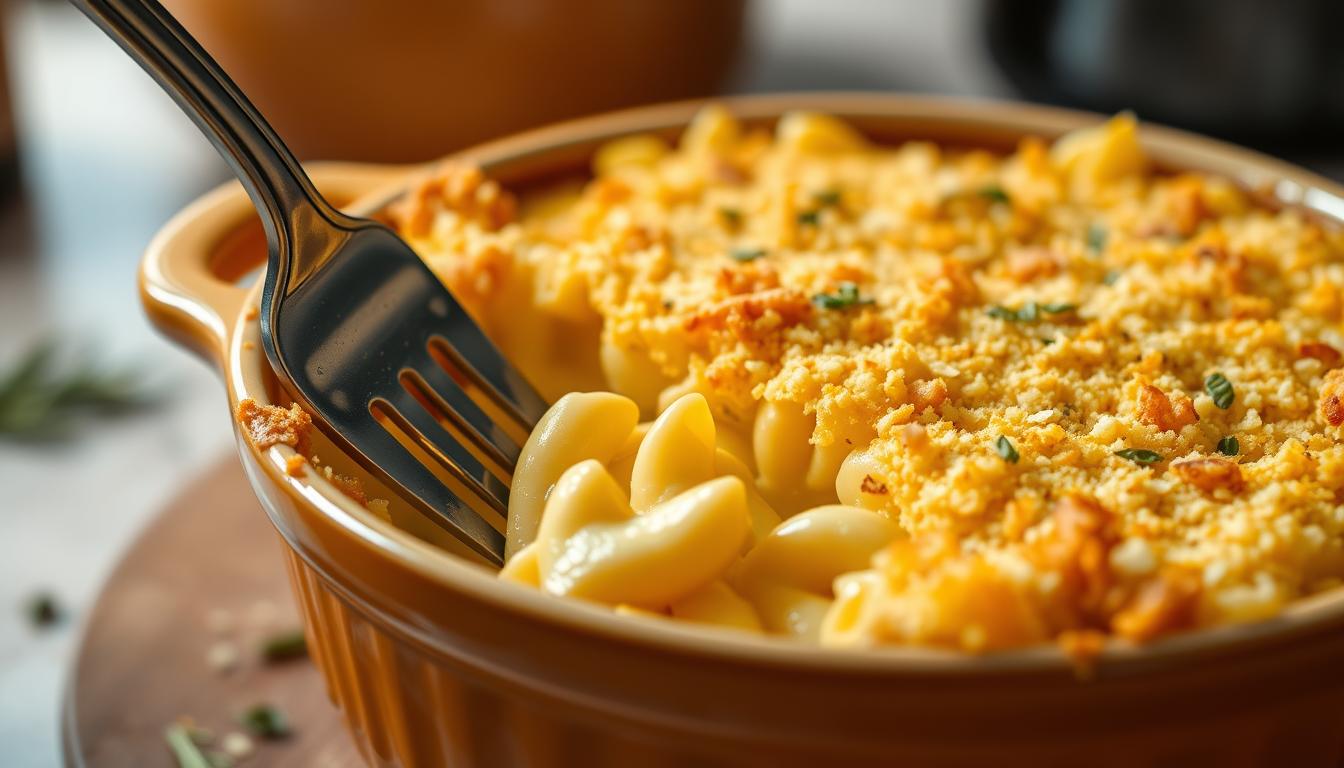Table of Contents
There’s something magical about homemade mac and cheese. It’s creamy, cheesy, and comforting. But what if you’re cooking just for one or two? I’ve perfected a small batch recipe that’s as rich and satisfying as the big batches.
This recipe is perfect for those moments when you crave comfort without the fuss. It’s a cozy ritual that fits your lifestyle. Let me show you how to make the best recipe for mac and cheese small batch.
Key Takeaways
- Learn the best recipe for mac and cheese small batch that’s easy to customize.
- Discover how homemade mac and cheese can be ready in under 30 minutes.
- Minimize waste with portions that serve 1-2 perfectly every time.
- Master techniques to achieve creamy texture in small quantities.
- Get tips for adding flavors like bacon or jalapeños to make it your own.
Why Small Batch Mac and Cheese Is a Game-Changer
Traditional recipes often leave you with mountains of leftovers, but small batches flip the script. This comfort food recipe adapts to real-life needs, offering flexibility without compromise. Here’s why it’s a kitchen revolution:
Perfect for Single Servings or Couples
No more eating the same meal for a week. My small-batch method lets you cook just enough for 1-2 people. Whether it’s a solo treat or a cozy date-night dish, every bite stays fresh. No more half-eaten containers!
Less Waste, More Flavor
Premium ingredients shine brighter in smaller portions. I use aged gouda or truffle-infused cheeses since there’s no risk of leftover spoilage. Less waste means you can splurge on quality without guilt. The cheese sauce stays velvety, never diluted.
Quick Mac and Cheese Without Leftovers
- Cook time cuts down to 15-20 minutes
- No guesswork—measure precisely for perfect texture
- Enjoy fresh, creamy bites every time
Quick mac and cheese isn’t just fast—it’s practical. No more waiting for big pots to boil. When cravings hits, this method delivers in a snap. Say goodbye to soggy leftovers and hello to meals that taste made-to-order.
Essential Ingredients for Creamy Perfection
Choosing the right ingredients is key to a creamy mac and cheese that wows. I’ve tried many recipes to find the best:
- Butter: Adds richness without overwhelming the dish.
- All-Purpose Flour: Forms the roux base for the sauce.
- Whole Milk: Full-fat milk prevents lumpy cheesy mac and cheese.
- Sharp Cheddar: My go-to for sharpness. Pair with gouda or fontina for depth.
Pro tip: Always grate cheese yourself—pre-shredded often contains anti-caking agents that inhibit melting. For texture, I use elbow macaroni—it traps sauce better than other shapes.
| Cheese Type | Melting Score | Flavor Profile |
|---|---|---|
| White Cheddar | 9/10 | Creamy with balanced saltiness |
| Gruyère | 8.5/10 | Buttery nutty notes |
| Monterey Jack | 8/10 | Smooth and mild, great for blending |
A splash of Dijon mustard or a pinch of nutmeg adds depth without overpowering the cheesy mac and cheese base. Experiment but stick to these fundamentals—the difference is noticeable!
Best Recipe for Mac and Cheese Small Batch
Ready to try the best recipe for mac and cheese small batch? This simple mac and cheese recipe serves two perfectly, with adjustments for one. Every step is designed to save time without skimping on flavor. Let’s get started!
Ingredient Measurements for Two Servings
| Ingredient | Amount |
|---|---|
| Macaroni | ½ cup uncooked (yields ~1½ cups cooked) |
| Unsalted butter | 2 tbsp |
| Flour | 2 tbsp |
| Milk | ½ cup (whole or 2%) |
| Cheese | 1 cup shredded cheddar (or mix with Gruyère) |
| Salt & pepper | To taste |
Time-Saving Prep Tips
- Grate cheese ahead of time and store in a sealed bag.
- Cook pasta and sauce in separate pans to multitask.
- Use a whisk to blend sauce smoothly—no lumps!
Nutritional Information
Each serving provides ~450 calories, 25g protein, and 15g fat. Swap ¼ cup milk for skim to cut 50 calories. Opt for whole-grain pasta for extra fiber.
Equipment You’ll Need for Stovetop Success
Perfect stovetop mac and cheese starts with the right tools. Whether you’re making an easy mac and cheese recipe for one or two, every piece of equipment plays a role in achieving that signature creamy texture.
Small Pot Options
- A 1-2 quart saucepan is ideal—like All-Clad’s 1.5-quart stainless steel pot—for even heating without overcrowding pasta.
- Non-stick options such as T-fal’s Essentials line prevent sticking but require gentle care.
Utensils for the Perfect Stir
Use silicone spatulas (OXO Good Grips works well) or wooden spoons to avoid scratching pans. Metal utensils can damage coatings, so skip them when using non-stick surfaces.
Measuring Tools for Precision
Small batches demand accuracy. My go-to tools include:
- Measuring spoons for cheese and butter portions
- A 1-cup liquid measuring cup for milk
- A kitchen scale for precise pasta weights (I use a Taylor digital model)
Without these, even tiny ingredient imbalances can ruin the sauce. Stick to these basics, and your stovetop mac and cheese will turn out flawlessly every time.
Choosing the Right Pasta for Your Small Batch
Choosing the right pasta is key for a great homemade mac and cheese. The best shapes trap sauce, making every bite full of flavor. Elbow macaroni, shells, and cavatappi are top picks because of their ridges that hold cheese sauce.
| Pasta Type | Best For | Notes |
|---|---|---|
| Elbow Macaroni | Classic Comfort Food | Traditional choice, traps sauce perfectly. |
| Cavatappi | Chunky Sauces | Spiral ridges hold grated cheese and herbs. |
| Shell Pasta | Stuffed Variations | Larger shells add texture to baked versions. |
| Gluten-Free Elbows | Dietary Needs | Look for brands that maintain chewiness. |
Cook small batches carefully. Reduce boiling time by 1–2 minutes to avoid sogginess. Overcooked pasta ruins even the best mac and cheese. For gluten-free options, test brands to ensure they stay chewy.
I’ve found that protein-enriched pastas add heft without losing flavor. Pair them with sharp cheddar for a satisfying meal. If you’re looking for more comfort food ideas, try this air fryer cottage cheese recipe for a protein-packed side.
The Secret to Ultra-Creamy Cheese Sauce

Making a velvety cheese sauce is key to a great creamy mac and cheese. My simple mac and cheese recipe has three steps to make it special. Let’s explore how to do it in small batches.
Creating a Roux in Small Quantities
- Use 1 tbsp butter + 1 tbsp flour for 2 servings
- Cook over medium heat until golden, but not brown
- Whisk constantly for 1-2 minutes to remove raw flour taste
Cheese Melting Techniques
Grated cheese melts smoother. Always:
- Shred cheddar, Gruyère, or Monterey Jack yourself
- Add cheese gradually once roux is warmed
- Remove pot from heat before final additions to prevent clumping
Achieving the Perfect Consistency
| Too Thick? | Whisk in 1 tsp milk 1 tbsp at a time |
|---|---|
| Too Thin? | Add ½ tsp flour mixed with water first |
My favorite mix is sharp cheddar with whole milk. Add a pinch of cayenne or Dijon mustard for extra flavor. It’s all about precision and patience!
My Favorite Cheese Combinations for Maximum Flavor
Cheesy mac and cheese needs a cheese blend that’s bold yet balanced. I mix a base cheese that melts well with a bold variety for depth. These ratios are tried and true for the best small batch mac and cheese:
- Sharp Cheddar + Smoked Gouda (3:1): Smoky gouda adds depth to cheddar’s tang. Top with crispy bacon for a savory kick.
- Aged Gruyère + Pepper Jack (2:1: Melted together, their nutty and spicy notes complement each other. Stir in diced tomatoes for a fresh contrast.
- Fontina + Parmesan (4:1: Fontina’s buttery texture softens parmesan’s sharpness. Pair with sautéed mushrooms for earthy richness.
Pair sharp cheeses with salty toppings like bacon or ham. Mild blends shine with veggies like roasted garlic or spinach. For budget-friendly magic, add a single spoonful of expensive cheese—like blue cheese—to elevate without overspending.
“A sprinkle of parmesan on top boosts flavor without needing a full block,” says my kitchen mantra.
Experimenting with these ratios turns any small batch into a crowd-pleaser. Even a tiny dash of truffle oil or hot sauce can elevate your cheesy mac and cheese. Let your taste buds guide you!
Delicious Add-ins to Elevate Your Mac and Cheese
Make your homemade mac and cheese even better with creative add-ins. Whether you’re cooking for one or two, these tips are easy and add flavor. Let’s see how to add proteins, veggies, and herbs to your dish.
Protein Options
For a filling meal, add protein. Try these:
- 1 oz crispy bacon bits (cooked while the pasta boils)
- ¼ cup shredded rotisserie chicken
- 1 oz cooked ground turkey or beef
- 2 oz imitation crab meat (for a decadent touch)
Vegetable Additions
Vegetables make your dish healthier and tastier:
- ¼ cup frozen peas (steamed until tender)
- ½ cup roasted garlic or caramelized onions
- ¼ cup diced roasted red pepper
- 1 small diced cherry tomato
Spice and Herb Enhancements
My top flavor tips include:
- Smoked paprika (½ tsp for smoky depth)
- Cayenne (a pinch for heat)
- Fresh parsley or chives as garnish
- Truffle oil drizzle (1 tsp)
My favorite mix? Bacon bits with smoked paprika. It’s my special homemade mac and cheese twist. Be bold but start small—remember, less is more in small batches!
Troubleshooting Common Small Batch Mac and Cheese Problems

Even the most skilled cooks can run into issues with quick mac and cheese. These tips will help you fix common problems and make every bowl perfect.
Fixing Grainy Sauce
Grainy cheese occurs when fats separate from milk solids. To fix it, lower the heat and slowly whisk in the cheese. If clumps still appear, add 1–2 tablespoons of warm milk or butter to mix it well.
I learned this trick after I accidentally burned a batch by adding cheese too fast!
Addressing Pasta Doneness Issues
- Undercooked pasta? Boil for 6–8 minutes for elbow macaroni. Check for doneness at 5 minutes to avoid mush.
- Overcooked? Toss with butter to restore texture before mixing with sauce.
Solutions for Sauce Thickness
Too thick? Stir in milk 1 teaspoon at a time. Thin sauces? Mix 1 tsp cornstarch with 2 tsp milk, then add to sauce while whisking.
Remember, small batches need careful attention. Adjust ingredients slowly—1 tablespoon at a time—to keep your mac and cheese creamy and consistent.
How to Serve Your Homemade Small Batch Creation
Serving your comfort food recipe with care makes a big difference. I always start by picking the right dish. A small cast-iron skillet, like Lodge, keeps the cheesy mac and cheese warm. Ramekins add a personal touch.
- Serving Vessels:
- Lodge 6-inch skillet for rustic warmth
- Earthenware ramekins for individual portions
- White porcelain bowls for classic appeal
Garnishes elevate the dish:
- Toasted panko breadcrumbs for crunch
- Chopped chives or parsley for freshness
- Crispy pancetta bits for salty contrast
| Beverage | Pairing Notes | Example Brands |
|---|---|---|
| IPA Beer | Malty sweetness balances richness | Sierra Nevada, Stone IPA |
| Cabernet Sauvignon | Full-bodied tannins complement cheese | Beringer, Cakebread Cellars |
| Sparkling water | Cleanses palate without heaviness | La Croix, Perrier |
For a cozy night in, I top it with truffle oil. When I’m hosting, a sprinkle of paprika adds color. Pair it with a simple side, like a baby spinach salad or roasted cherry tomatoes. This cheesy mac and cheese is perfect for any occasion.
Making Ahead and Storage Tips for Single Servings
Planning ahead? Here’s how to keep your quick mac and cheese fresh and tasty. My experiments show proper storage keeps leftovers creamy and ready to enjoy later. Let’s break down the best strategies.
Refrigeration Guidelines
Store leftovers in airtight containers within 2 hours of cooking. My tests proved simple mac and cheese recipe batches last up to 3 days in the fridge. Always check for mold or off smells before reheating.
Reheating Without Drying Out
Revive leftovers with these methods:
- Stovetop: Add 1-2 tbsp milk, stir over medium heat until warm.
- Microwave: Cover with a damp paper towel, heat 30 seconds at a time, stirring between intervals.
- Oven: Bake at 350°F for 10-15 minutes, covered, for a crispy top.
Freezing Small Portions Successfully
For longer storage, freeze portions in labeled, freezer-safe containers. Leave ½ inch headspace. My trials showed best results when thawed overnight in the fridge before reheating. Discard after 1 month.
Experiment with these tips to keep your comfort food fresh. Adjust methods based on your schedule—your quick mac and cheese deserves to stay delicious every time!
Conclusion
Learning the best recipe for mac and cheese small batch is key to quick, tasty meals. It’s perfect for one person or a couple. This dish shows that comfort food can be simple and satisfying, without needing a lot of ingredients.
The tips on making the perfect roux and blending cheeses make a big difference. They turn basic ingredients into a delicious dish. Plus, you can add your favorite flavors, like bacon or smoked paprika, to make it your own.
Don’t be afraid to try new things. Start with the basics and then add your own twist. I always have cheddar, Gruyère, or pepper jack ready for a quick change. Making small batches is easier and more flexible, great for any night.
Boxed mixes can’t compare to homemade mac and cheese. It’s richer in flavor and lets you choose what goes in. So, the next time you’re hungry, get cooking. Your taste buds and the planet will appreciate it.

